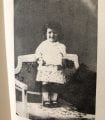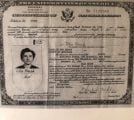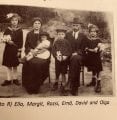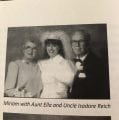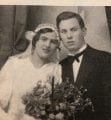- Local Survivor registry
- ELLA REICH
- Local Survivor registry
- ELLA REICH
Survivor Profile
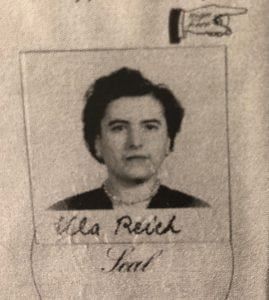
ELLA
REICH
(1913-2011)
PRE-WAR NAME:
ELLA HECHT
ELLA HECHT
PLACE OF BIRTH:
SVALYAVA, CZECHOSLOVAKIA
SVALYAVA, CZECHOSLOVAKIA
DATE OF BIRTH:
DECEMBER 20, 1913
DECEMBER 20, 1913
LOCATION(s) BEFORE THE WAR:
SECOVCE
SECOVCE
LOCATION(s) DURING THE WAR:
NAGYSZOLLOS, HUNGARY (GHETTO) ; AUSCHWITZ; NUREMBERG, GERMANY; HOLZOV, CZECHOSLOVAKIA (FORCED LABOR CAMPS)
NAGYSZOLLOS, HUNGARY (GHETTO) ; AUSCHWITZ; NUREMBERG, GERMANY; HOLZOV, CZECHOSLOVAKIA (FORCED LABOR CAMPS)
STATUS:
SURVIVOR
SURVIVOR
RELATED PERSON(S):
ISADORE REICH - Spouse (Deceased),
OLGA GOTTESMAN SISTER (Deceased),
MORRIS GOTTESMAN BROTHER IN LAW (Deceased),
MIRIAM F. DOBIN NIECE
-
BIOGRAPHY BY MIRIAM F. DOBIN, NIECe "aunty's story"
“Aunty’s Story” excerpted by Nancy Gorrell from Miriam Dobin’s Memoir, I Am Because of You.
My name is Ella Reich. I got married in August of 1935 to Isadore Reich. We lived in Secovce, Czechoslovakia. In 1938 Isadore was called to the army. Hungary took back parts of Slovakia, and my parents now live on the border in Oborin and we live in Hungary. When Isadore returned, news was bad from Germany. We began to feel frightened in 1939. I cannot remember the exact date but around 1940, we had to wear the yellow arm band on our sleeve. Later they changed it to the Jewish star. In 1941 we learned that Jews were being persecuted by the Germans in Poland. Rumors began that the Germans would start to take the Slovak Jews away. By 1942 the Slovak Jews were being taken away. We knew we would have to leave our apartment and go into hiding. In February 1942 we withdrew money from our bank, went across the border and went to my parent’s home in Oborin. We stayed only for a day. It was a border town and we would have been noticed. Then we went to Kiraly-Helmec where my sister Olga lived with her husband. We stayed a few days. We had to move around because people would recognize us as strangers. We moved around every few months. Isadore got a message from his boss that he had a permit to keep working in the textile story where he worked before he ran away. I stayed by my sister’s home. A couple of months later, I got a message that Isadore was going to Miskolc, Hungary, and that I should meet him there. Then our wandering began. . .
It’s difficult to express the fear I felt to travel. We were afraid to be seen together because strangers were noticeable. My husband, Isadore Reich, was called over to City Hall. He was called a second time, but he was afraid of being put in jail or a labor camp if we went back, so we left for Budapest. We got false papers and were able to travel. We stayed with two cousins in an apartment and we looked for work. Men Isadore’s age couldn’t be found on the streets. Isadore was almost 33 at the time and I was almost 30.
We went back to Kiraly-Helmec. We heard another cousin of ours from Slovakia had been caught while hiding. The man that gave us the false papers reported them. It was good that we left Budapest. Then we went to Iloncza. We stayed with Isadore’s sister. Then we moved to Nagyszollos. We stayed with Jewish people. We always had to keep moving. Raids were common. We lived almost two years in Nagszollos. We stayed by a very religious family. We paid them for the room and they fed us. It was 1944 and I guess my parents were already taken. I don’t know when or how. The Nazis established a ghetto in Sollos. This is where Isadore and I were already living. They were taking people to City Hall and beating them. Isadore had an idea. He asked an officer to take him to the ghetto (to avoid the beating and City Hall). It was April 1944, the second day of Passover when we went to the ghetto. In the beginning of June they started to empty the ghetto; we were on the third transport going to Auschwitz.
The men and women were separated. Those told to go left were never seen again. Then I saw Dr. Mengele. He asked if I was willing to work. Surely, I said, “Yes.” I went to the right. I went to a building to take a shower. My hair was cut off. We came to a gate, went through and saw barracks. There were 30. We were marching. I heard my name; Ella Hecht. A second cousin of mine, Ilush Roth, pulled me out of the line and said, “Your mother and sisters are here.” I was happy to be with my family. I was in the same barracks with my mother and three sisters.
Then started life in Auschwitz concentration camp. There was appel every morning…when there was selection, me and my sister Olga ran to another barrack. We would stand five in a row…It was Wednesday that year, Yom Kippur. Thursday was selection for our barracks, number 31. Olga and I stood in the row behind my mother and two sisters. Mengele was there. We saw our mother and two sisters go to the left. We went further in. They were selected and went to another barracks. We never saw them again. They were killed two days later.
My sister, Olga, and I were selected to go to work. We were taken by open cattle trains in October 1944 to Nuremberg. It was a new camp. We got a room with a stove in it. We received meals. We hadn’t been there too long when bombs were falling from American and English planes. We had to run to shelters. I think it was January when they took us to work. We were wiring wheels for airplanes in a factory. Finally, they took us away because it was impossible to work there.
They took us to Holysov, Czechoslavkia. It was a work farm. This was spring of 1945. Then one day were didn’t see any guards. We heard help is near. Then the partisans came (May 5, 1945). They took us into Holysov. The next day the American Army came in. Trucks of American soldiers threw chocolates. This was really the end of the war. We were happy to be alive.
We stayed there for four weeks. Bread was given to feed us. After four weeks Olga and I said we wanted to go home to Galszecs) Secovce in Hungarian)
They took us first to Prague. Olga was married but she hadn’t heard from her husband since he’d been taken for forced labor at the end of 1942. They put us on trains to Morava and onto Bratislava. This was the end of June 1945…Finally someone recognized me and “you know, your husband is home in Galszecs” …My sister and I stayed together throughout. We arrived in Kassa and we found the people my husband was working for, the Wintners. We stayed by one of their sons and they let my husband know we were here. Isadore came for us. “I was miraculously united with my husband.”
Isadore was living in the Wintner’s house. They were old people and when he came home, they were feeding him, he was so weak. Olga didn’t find her husband and heard he died in the camp. My father and two brothers died too. Isadore’s full family was killed. Everyone was gone.
First, we went to Oborin to my parent’s house. We spoke with the neighbors who kept the clothing and furniture and valuables from my family in case someone came back. They did return these possessions. Olga went with Isadore to Kraly-Helmec and found her belongings and brought them back.
The Wintner family looked at Isadore like a son. They were selling wholesale textiles. Isadore was with them for many years when we got married, and he was making a living and learned the business. He took in a partner because it was easier. He made a good living. We didn’t intend to stay there; we couldn’t. We had relatives in America. Isadore wrote to his cousins and they sent us money. He wrote to them to send papers so we could emigrate to America and papers for Ella’s sister too. That’s what we did. They sent us papers and tickets too.
We had to wait a long time after applying for a visa to come to America because there was a quota. This was 1945. We had passports to go to Urugary and Paraguay but we waited for American visas. Finally, on December 31, 1948, we crossed the border from Czechoslavokia into Poland. We went to the harbor of Odraport. On January 1, 1948 we took a ship to Sweden. From there we boarded the Gripsholm (a Swedish-American line) that went to Canada and then the United States. For 11 days Isadore, me and Olga, my sister) were on the seas. Finally, we arrived in New York harbor.
My uncle and Isadore’s uncle and cousins were waiting for us and we came to them in Newark, New Jersey. We went to night school to learn English, and in 1954 we became United States citizens. Isadore found a good job in Two Guys, a department store in Woodbridge, New Jersey where he became manager of the fabric department. I knew how to sew, so we opened a small dress shop… “We could never get over what happened. It has never left us. We lived together almost 60 years, married happily. No children. He just passed away. He would have been 86 years old on June 1.
Editor’s Notes:
Refer to www.Iambecauseofyou.net to hear Aunty’s story in her own voice.
Refer to Voices of the Descendants for Miriam Dobin’s Registry
-
SURVIVOR INTERVIEW:
Refer above to “Aunty’s Story” from Miriam Dobin’s memoir, I am Because of You .
-
Sources and Credits:
Credits:
Biography, “Aunty’s Story,” from I Am Because of You by Miriam Dobin, Niece (2015).
The SSBJCC Holocaust Memorial and Education Center gratefully acknowledges the donation by Miriam Dobin of her memoir, I am Because of You (2015) and digital historic and family photographs and documents therein. website: www.Iambecauseofyou.net. I Am Because of You available at amazon.com


